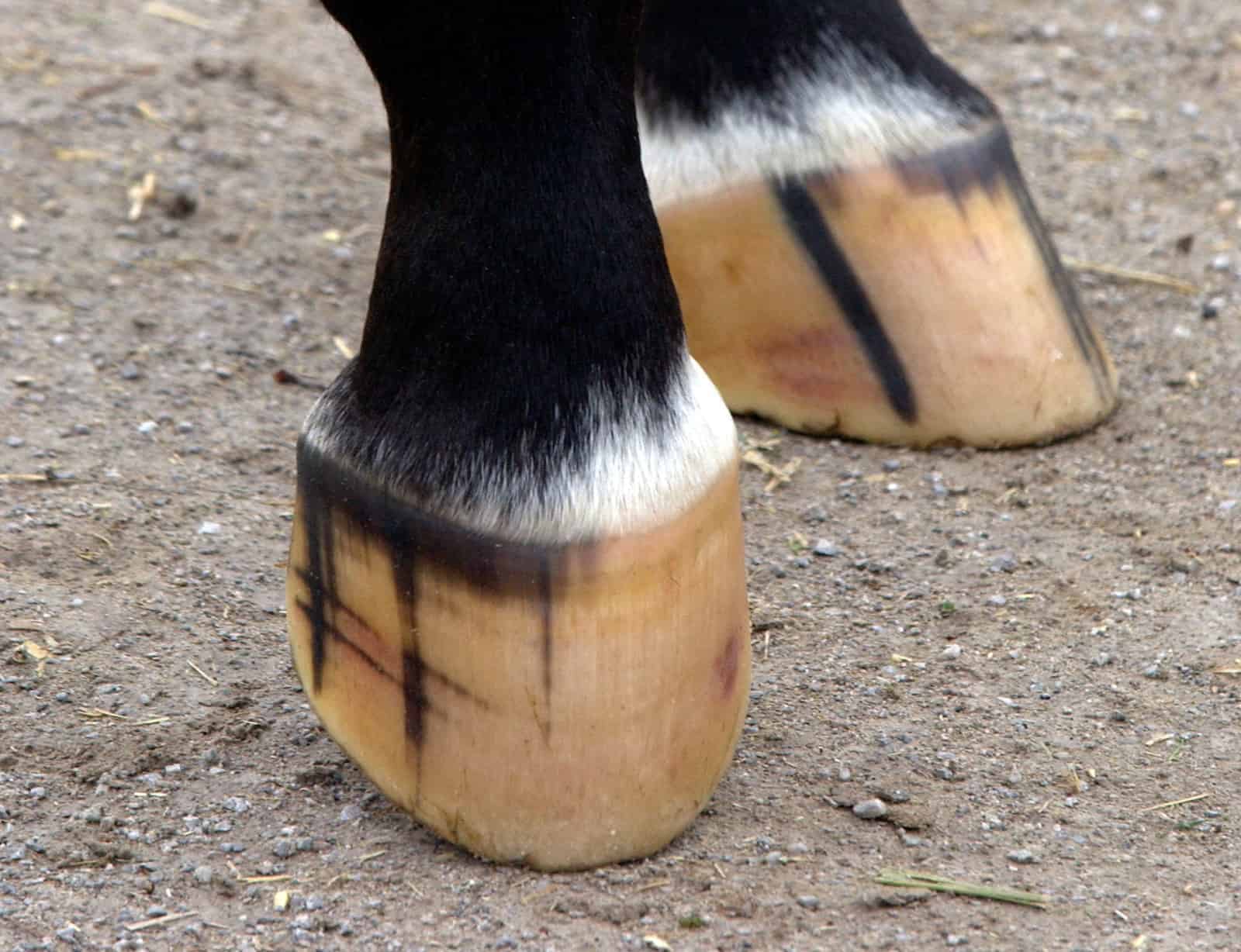4 Horse Hoof Hardening Tips
- Topics: Article, Hoof Care, Hoof Care & Balance, Hoof Cracks, Hoof Problems, Horse Care, Lameness

“A hoof can’t harden as quickly as the ground freezes when temperatures drop (after warm daytime temperatures),” said Heath Lash, a certified farrier from Angola, Indiana. “That’s when chunks are broken out of the hoof wall and hooves weaken.”
Good maintenance—both of the horse and his living area—goes a long way in hardening hooves. Follow these four tips this season.
1. Keep the horse’s environment clean.
Whether a horse has access to a stall or is on full turnout, providing a dry area free from mud and excess manure is key to promoting hoof health. If the horse doesn’t have stall access, improve drainage around shelter areas so he has space to get out of wet mucky areas, allowing his hooves time to dry. For horses with stall access, picking their feet and giving them time in a clean, bedded stall, helps, Rucker said.
“Horses that live in mud, or worse, mud with manure or rotting hay mixed into it, have poor-quality feet,” she said.
2. Feed a balanced diet.
Work with a veterinarian or an equine nutritionist to ensure your horse’s daily ration provides all the nutrients he needs. If your vet or nutritionist identifies any deficiencies, supplement is necessary. In most horses, consuming the water-soluble B vitamin through pasture and alfalfa and through production of biotin by microbes in the horse’s hindgut is enough for healthy hair coat and hoof growth. However, horses with brittle, weak hooves or frequent shoe pulling might benefit from additional biotin in their diet.
R.F. “Ric” Redden, a renowned veterinarian and farrier of the International Equine Podiatry Center, based in Versailles, Kentucky, recommends a startup dose of 100 milligrams of biotin per day. Once hoof wall quality shows improvement in the new growth, which can take weeks to months, you can reduce doses to 50 milligrams per day and, over time, potentially further, he said.
“I suggest the owner get feedback from their farrier in six to eight weeks, which can be a good indicator, especially if the farrier has been unaware of the addition of the 100-milligram daily dose,” he said.
In research, scientists have debated biotin’s effectiveness. Studies reporting successful results suggest that feeding as little as 15 to 20 milligrams of supplemental biotin per day was effective for improving hoof growth (Buffa et al., 1992; Reilly et al., 1998). But scientists haven’t performed additional studies since then.
3. Promote good circulation.
Hoof growth depends on adequate nutrient blood flow to the tubular and solar papillae. The mechanical relationship between the suspension and support components apparently determine how well blood is delivered to the specialized cells responsible for producing the cornified cells that compose horn wall, sole, and bars, Redden explained.
“Mechanically enhancing the patency of the vessels that feed the germinal centers offers a direct means of stimulating horn growth, which can offer medical benefits for the feet with marginal quality horn and slow growth, as well as those altered by injury and or disease,” he said.
Feet are not equal, and they have unique characteristics and influences, such as environment, wear, growth, age, nutrition, and genetics. Exercise alone isn’t enough to encourage foot growth, but regular activity and specific hoof trimming methods can help support circulation.
“The four-point trim and/or mechanical rockers (which shorten the toe and move the breakover back) can quickly promote sole depth and subsequently accelerate wall growth,” Redden said. “Both are a bit technique sensitive, as they are considerably different than the traditional flat trim; however, many farriers and vets have found the concept to offer predictability and favorable benefits for marginal quality walls and thin soles.” These approaches are mechanical means of reducing deep flexor tension that in turn enhances blood supply to the germinal growth cells, he said.
4. Use topicals? Maybe.
Topical hoof hardeners have mixed reviews. Difficult horses might need a hoof hardener painted onto the wall and sole before and after turnout, said Rucker. Hoof hardeners can be helpful, especially if you eliminate exposure to excessive moisture, said Redden. But the traditional mud or clay used used to pull heat from the feet starts a vicious cycle that can quickly destroy the strength and durability of even the best feet when they maintain too much moisture, he said.
“Once waterlogged, the heel tubules no longer have structural stability, lose natural recall, and subsequently fold inward and forward,” he said. “Add exercise and speed, and we have a perfect recipe for perpetuating the proverbial crushed heel.”
Written by:
Katie Navarra
Related Articles
Stay on top of the most recent Horse Health news with















